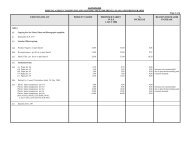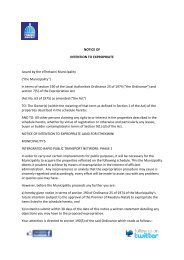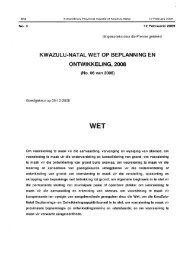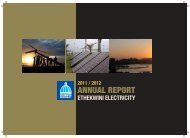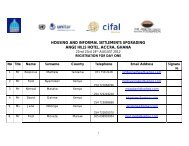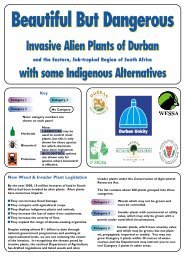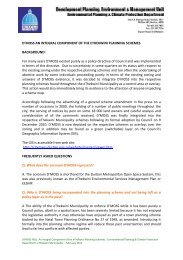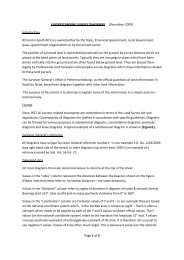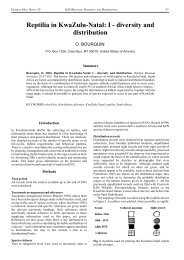Mullin, S. K., Taylor, P. J. & Pillay, N. 2004. Skull size and ... - Durban
Mullin, S. K., Taylor, P. J. & Pillay, N. 2004. Skull size and ... - Durban
Mullin, S. K., Taylor, P. J. & Pillay, N. 2004. Skull size and ... - Durban
Create successful ePaper yourself
Turn your PDF publications into a flip-book with our unique Google optimized e-Paper software.
MULLIN_08 13/08/04 12:45 Page 21<br />
from South Africa than East Africa. Both Osgood<br />
(1936) <strong>and</strong> Rosevear (1969) considered D. foxi<br />
<strong>and</strong> D. rufulus to be subspecies of D. incomtus,<br />
which is not correct, <strong>and</strong> recommended that neither<br />
D. foxi nor D. rufulus should attain species<br />
status as both forms appeared similar to each<br />
other with respect to pelage colour, body <strong>size</strong> <strong>and</strong><br />
cranial shape <strong>and</strong> <strong>size</strong>. Carleton & Martinez<br />
(1991) confirmed that external measurements of<br />
both species overlap <strong>and</strong> that both have similar<br />
pelage colours, but felt that the wider skull, larger<br />
molars <strong>and</strong> general larger <strong>size</strong> of D. foxi <strong>and</strong> the<br />
slightly redder colour of D. rufulus adequately<br />
separated the two groups at a species level.<br />
In this study, the taxonomic position of D. foxi<br />
was slightly confusing as it was typically found on<br />
the periphery of, but always separate from, D. rufulus<br />
in the macro scale analyses, but appeared to have<br />
a similar skull <strong>size</strong> <strong>and</strong> shape to D. rufulus in the<br />
micro scale analyses. Put another way, the macro<br />
scale analysis suggested that D. foxi represented a<br />
good morphological species while the micro scale<br />
analysis indicated that it represented a valid subspecies<br />
of D. rufulus rather than a separate species.<br />
However, the remainder of the analyses indicated<br />
that D. foxi was a valid species that separates from<br />
D. rufulus. The phenogram based on the 11 morphological<br />
groups clearly showed D. foxi as separate<br />
from D. rufulus <strong>and</strong> the results from the<br />
ANOVA showed that the overall larger D. foxi<br />
was significantly larger than D. rufulus with<br />
respect to upper toothrow length (UTR) <strong>and</strong><br />
P R O O F<br />
greatest skull height (GHS). Therefore, we sug-<br />
gest that D. foxi should be retained as a species.<br />
Eisentraut (1963) originally examined D. montanus,<br />
which is restricted to high altitudes in the<br />
Ruwenzori Mountains of Ug<strong>and</strong>a, <strong>and</strong> suggested<br />
that this subspecies be awarded species status (i.e.<br />
D. montanus) due to longer <strong>and</strong> darker pelage as<br />
well as a shorter tail than D. incomtus. Dasymys<br />
montanus was considered a valid species by<br />
Musser & Carleton (1993), despite it never having<br />
been statistically examined prior to this study.<br />
Dasymys montanus certainly has both darker <strong>and</strong><br />
longer pelage that other Dasymys <strong>and</strong> this study<br />
showed it to have a small <strong>size</strong> (in both external<br />
<strong>and</strong> cranial measurements) <strong>and</strong> the shortest tail<br />
MAMMALIA • 2004 • 68 (2)<br />
African Dasymys systematics<br />
length as well as the smallest head-body/tail ratio,<br />
making all of these features good distinguishing<br />
characteristics. Montane forms generally have a<br />
smaller <strong>size</strong> <strong>and</strong> darker pelage (Kingdon 1974;<br />
Misonne 1974), in accordance with Bergmann’s<br />
(1847) <strong>and</strong> Gloger’s (Rapoport 1969) Rule.<br />
Other endemic rodent species, considered relict<br />
populations, seem to be common not only from<br />
Mount Ruwenzori but also from other Mountains<br />
in east Africa (e.g. Mt Elgon, Mt Kenya; Maddalena<br />
et al. 1989; Van der Straeten & Peterhans 1999;<br />
Clausnitzer & Kityo 2001; <strong>Taylor</strong> & Kumirai<br />
2001). We recommend that D. montanus be considered<br />
a distinct species based on its skull <strong>size</strong> <strong>and</strong><br />
shape especially when its restricted habitat is considered.<br />
We attempted to examine correlations between<br />
environmental factors <strong>and</strong> both skull <strong>size</strong> <strong>and</strong><br />
shape of all of the morphologically defined<br />
Dasymys species by analyzing rainfall <strong>and</strong> temperature<br />
data primarily to ascertain the effects of the<br />
environment on the high-altitude forms, D. montanus<br />
<strong>and</strong> D. i. longipilosus. We obtained weather<br />
data from the National Oceanic <strong>and</strong> Atmospheric<br />
(NOAA) database (www.ncdc.noaa.gov/ol/climate/<br />
research/ghcn/ghcn) <strong>and</strong> to ensure the relevance<br />
of the weather data, we chose the closest weather<br />
station (within 1 degree of latitude, 1 degree of<br />
longitude <strong>and</strong> 500 m of altitude) to each locality.<br />
A problem arose, however, in trying to obtain<br />
weather data for the localities representing these<br />
two montane forms as there were no weather stations<br />
within an acceptable distance to the localities<br />
(mainly in terms of altitude), making the<br />
analysis of environmental correlates impossible.<br />
Therefore, it does not seem possible to ascertain<br />
whether D. montanus or D. i. longipilosus constitute<br />
altitudinal races or represent valid species.<br />
Dasymys nudipes has long been considered a valid<br />
species that is separate from D. incomtus based on<br />
its large <strong>size</strong> <strong>and</strong> the fact that it has five plantar<br />
pads, unlike the other Dasymys specimens which<br />
have six (Cabrera & Ruxton 1926; Crawford-Cabral<br />
1983; Crawford-Cabral & Pacheco 1989). Both<br />
the morphological data <strong>and</strong> the ANOVA results<br />
presented in this study confirmed the distinctness<br />
of D. nudipes <strong>and</strong> that this species generally had<br />
21


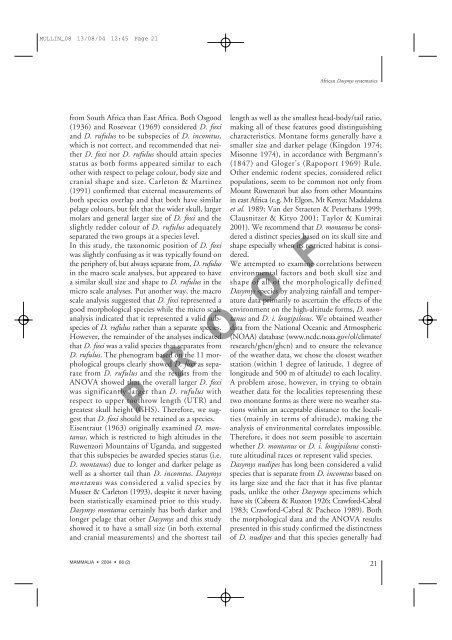
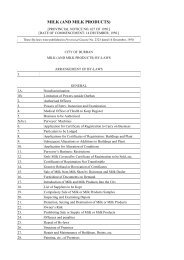
![INK Environmental Sustainability Booklet [19 MB] - Durban](https://img.yumpu.com/22025104/1/190x136/ink-environmental-sustainability-booklet-19-mb-durban.jpg?quality=85)

